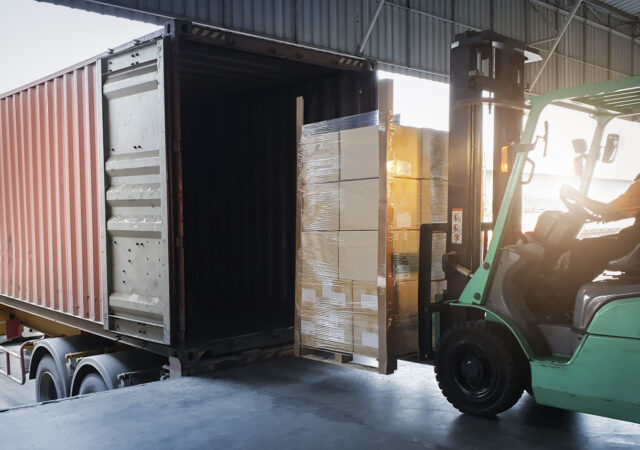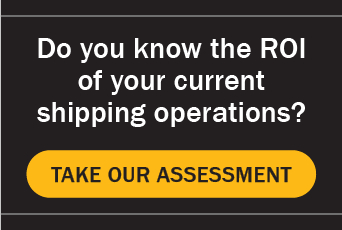LTL vs. Parcel: What’s the Difference?

Every day, millions of products are transported across the globe—some in boxes small enough for one person to carry, and others secured by pallets that have to be moved with a forklift.
Naturally, the size of a shipment determines the method used to transport it. That’s where LTL and parcel shipping come in. This article will define each one, summarize the differences between them, and help you decide which to use for your shipments.
What is LTL shipping?
LTL (less-than-truckload) shipping is generally used for shipments that weigh between 150 and 15,000 pounds and/or have specialized handling requirements. While LTL shipments are too big or bulky for carriers to handle, they don’t require an entire truckload. To optimize space and costs, LTL shipping combines goods from different companies into a single truck, and businesses only pay for the space their products take up. With LTL shipping, businesses have the flexibility to send large shipments in a timely, affordable way.
LTL shipping is commonly used for B2B (business-to-business) deliveries, where quantities are often large. Examples of products frequently shipped via LTL include the following:
- Furniture: Bulky furniture items like couches or dining tables
- Appliances: Refrigerators, washing machines, and other large appliances
- Building materials: Construction materials like lumber or tiles
- Heavy equipment parts: Machinery components and parts too big for standard parcel shipping
- Electronics: Large electronic devices that require careful handling
- Car parts: Bulk shipments of car parts or accessories
- Palletized goods: Any goods that can be palletized and don’t require a full truckload
What is parcel shipping?
Parcel shipping is used to ship individual packages that weigh under 150 pounds and can easily be handled and transported by carriers. These small, lightweight packages don’t require extra equipment (like forklifts or tractors) to load, unload, or sort.
Parcel shipping is often associated with direct-to-consumer (DTC) ecommerce, where customers place orders online and have packages shipped directly to their addresses. With the rise of ecommerce, parcel shipping has skyrocketed. In 2022, over 161 billion parcels were shipped globally, and that number is predicted to increase each year.
LTL vs. Parcel: 7 Key Differences
Parcel vs. LTL—which is the best shipping method? That’s sort of a trick question. When choosing between LTL and small parcel shipping, it’s not a matter of picking the “best” option. The best option for your business depends entirely on the products you’re shipping and the factors below. So without further ado, let’s look at several key differences between LTL and parcel shipping.
1. Shipment Size and Weight
LTL shipping is ideal for larger, heavier shipments that don’t require a full truck. It’s also the best option for oddly-shaped products that are difficult to handle without help. Parcel shipping, on the other hand, works well for smaller packages that can be easily managed by a single person. As mentioned above, anything under 150 pounds is a good candidate for parcel shipping.
For example, if you’re shipping queen-sized mattresses, you’ll want to use LTL shipping, because a parcel delivery driver would probably have a hard time loading or unloading mattresses on their own. On the other hand, you could ship pillows individually using parcel shipping, since warehouse workers and delivery drivers could easily carry the packages.
2. Handling Requirements
Handling requirements are a major differentiator between LTL and parcel shipments. LTL shipments usually involve palletized or crated goods. This requires specialized equipment for loading and unloading, including forklifts, conveyor systems, and loading ramps. Parcel shipments, being smaller, are usually loaded and unloaded by hand, without help from heavy machinery.
3. Transit Speed
Because carriers optimize their operations for quick residential and business deliveries, parcel shipping is usually the fastest option for small, lightweight packages going to consumers. With parcel shipping, packages can be delivered in a matter of days.
LTL shipments involve multiple businesses, each with their own goods and delivery requirements. Because of this, trucks need to stop frequently at terminals for loading and sorting. Additionally, special equipment is often required to move heavy, bulky freight. The frequent stops and additional handling result in longer transit times.
4. Tracking
Parcel shipping lends itself well to real-time tracking. Parcels move from hub to hub until they reach the final destination, often passing through many distribution centers. At each checkpoint, their label is scanned and their location is updated in the system.This makes it easy for shippers and their customers to monitor a package’s progress throughout every stage of the shipping process.
While LTL tracking is available, it’s less granular. Although LTL shipments stop often at terminals for freight consolidation, they don’t make many stops on the last leg of the journey. This is because the goal of LTL shipments is to optimize shipping costs by moving goods in the most direct path from the supplier to the end customer. You can still receive updates at key checkpoints, but the tracking data won’t be as detailed.
5. Damage or Loss Risk
While parcel shipping is great for tracking, it also puts packages at risk of getting damaged or lost. When you ship parcels, they pass through many hands, frequently getting loaded, unloaded, sorted, and resorted. This constant movement creates more opportunities for individual packages to be misplaced or mishandled.
LTL shipments have the advantage here. They’re usually handled as larger units on pallets or in crates, which keeps them protected from damage—it’s a lot less likely for a forklift to drop an entire pallet of goods than it is for a human to drop a single package. And because the products are handled less, they’re less likely to get lost in transit.
6. Pricing Model and Cost
Parcel and LTL shipments use different pricing models. When shipping parcels, cost is determined by factors like weight, dimensions, distance, and delivery time. LTL shipping takes into account weight and distance, but it looks at another factor too: freight class.
The National Motor Freight Classification (NMFC) sorts freight into several categories. The NMFC assigns shipments into classes based on four variables: density, handling, stowability, and liability. In simple terms, the easier something is to move, the less it will cost to ship using LTL. For more information on determining freight class, read NMFC’s guide here.
Is it cheaper to ship parcel or LTL? For large, heavy items, LTL shipping is generally the most cost-effective option. The total cost is divided among multiple sellers, so you only pay for the space your goods take up on the truck. On the other hand, parcel shipping is more cost-effective for smaller and lighter packages, especially for direct-to-consumer deliveries.
7. Residential Delivery Options
Parcel shipping, which focuses on smaller packages and doorstep delivery, is most commonly used for residential delivery. While LTL can be used for direct-to-consumer deliveries, it comes with many challenges. For one thing, navigating residential areas can be difficult for large freight trucks. Then you need to consider how the driver will unload the shipment. Will they need special equipment? Does the consumer expect them to bring the product inside the house? Because of challenges like these, using LTL for residential delivery comes with extra fees that drive the cost up significantly.
When to choose LTL shipping
Ask yourself these questions to determine whether you should go with LTL shipping.
- Is the shipment large and heavy—over 150 pounds?
- Does the shipment involve palletized or crated goods that require specialized handling?
- Can the company wait for slightly longer transit times?
When to choose parcel shipping
If you answer yes to the questions below, parcel shipping is your best bet.
- Is the shipment small enough to meet carrier size and weight limits (usually under 150 pounds)?
- Are the goods easy for individuals to handle without the need for palletization or specialized equipment?
- Is speed a priority?
Optimize your LTL and parcel shipments with EasyPost Enterprise
Managing your shipping operations can sometimes feel chaotic and overwhelming—but the LTL versus small parcel decision doesn’t have to be. Whether you’re sending parcels, LTL shipments, or both, EasyPost Enterprise simplifies your carrier integrations, improves shipment processing speed, and reduces shipping costs.





